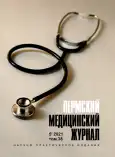Контаминация объектов окружающей среды Астраханской области гельминтно-протозойными инвазиями. Анализ деятельности ФБУЗ «Центр гигиены и эпидемиологии в Астраханской области» за 2011–2020 гг.
- Авторы: Шеметова С.А.1, Аракельян Р.С.2, Никешина Т.В.1,2, Шендо Г.Л.1, Мукашева А.К.3, Киселева С.В.3, Кравченко Д.А.2, Коваленко А.В.2, Петрухнова М.Ф.2
-
Учреждения:
- Центр гигиены и эпидемиологии в Астраханской области
- Астраханский государственный медицинский университет
- Филиал «НВЛЦ» ООО «КДЛ Домодедово-тест»
- Выпуск: Том 38, № 5 (2021)
- Страницы: 123-136
- Раздел: Профилактическая и социальная медицина
- URL: https://bakhtiniada.ru/PMJ/article/view/64780
- DOI: https://doi.org/10.17816/pmj385123-136
- ID: 64780
Цитировать
Полный текст
Аннотация
Цель. Изучить и проанализировать контаминацию объектов окружающей среды Астраханской области (на примере исследования проб почвы, воды и смывов с твердых бытовых поверхностей) по результатам лабораторных исследований ФБУЗ «Центр гигиены и эпидемиологии в Астраханской области» за 2011–2020 гг.
Материалы и методы. Работа проводилась на базе лаборатории бактериологических и паразитологических исследований ФБУЗ «Центр гигиены и эпидемиологии в Астраханской области» и в лабораториях филиалов ФБУЗ «Центр гигиены и эпидемиологии в Астраханской области» в 2011–2020 гг. Всего за анализируемый период лабораторией и филиалами были проведены лабораторные исследования 79 742 проб, отобранных с различных объектов окружающей среды, выполнено 94 495 исследований. Число проб, не отвечающих гигиеническим нормативам, составило 1,01 % (806 проб).
Результаты. Объектами отбора проб для исследования их на паразитарную чистоту служили вода, почва и смывы с твердых бытовых поверхностей.
Доля проб воды в структуре всех исследованных проб, отобранных с объектов окружающей среды, составила 7,3 % (5858 проб), из которых контаминированными возбудителями паразитарных заболеваний оказались 172 пробы, экстенсивность инвазии составила 2,9 %. Структура положительных находок в пробах воды была представлена шестью нозологическими формами гельминтов – 88,0 % (154 пробы) и тремя нозоформами простейших – 12,0 %. Доля исследованных проб почвы в общей структуре санитарно-паразитологических исследований окружающей среды составила 11,2 % (8895 проб). Число неудовлетворительных проб в структуре всех положительных находок, выявленных при исследовании почвы, воды и смывов за анализируемый период, составило 70,4 % (625 проб). Общая контаминация почвы за период 2011–2020 гг. составила 7,0 % (625 проб). В большинстве случаев были выявлены яйца и личинки гельминтов – 99,8 % (624 пробы). Доля выявленных в почве цист патогенных простейших составила 0,2 % (одна проба).
Кроме проб воды и почвы, проводились исследования смывов, отобранных с твердых бытовых поверхностей, – 81,5 % (64 989 проб), из которых неудовлетворительными оказались 0,01 % (9 проб).
Все положительные находки в смывах были представлены двумя нозологическими формами гельминтозов: яйцами Enterobius vermicularis – 0,012 % (8 проб) и онкосферами тениид – 0,002 (одна проба).
Выводы. Наличие яиц гельминтов и цист патогенных кишечных простейших в исследованных образцах почвы и воды свидетельствует о загрязнении данных объектов фекалиями инвазированных людей и/или о загрязнении его канализационными стоками, возникшими вследствие различных аварий. Наличие яиц токсокар и личинок стронгилид в почве и воде свидетельствует о загрязнении данных объектов фекалиями инвазированных животных (собаки, кошки). Наличие положительных находок в пробах сточной воды свидетельствует о некачественной дезинвазии данных объектов. Наличие яиц контактных гельминтов в исследованных пробах смывов с твердых поверхностей, свидетельствует о непосредственном контакте инвазированных людей с данными образцами.
Ключевые слова
Полный текст
Открыть статью на сайте журналаОб авторах
Светлана Александровна Шеметова
Центр гигиены и эпидемиологии в Астраханской области
Email: rudolf_astrakhan@rambler.ru
ORCID iD: 0000-0002-3066-2676
Врач-паразитолог лаборатории бактериологических и паразитологических исследований
Россия, Астраханская областьРудольф Сергеевич Аракельян
Астраханский государственный медицинский университет
Автор, ответственный за переписку.
Email: rudolf_astrakhan@rambler.ru
ORCID iD: 0000-0001-7549-2925
доцент, кандидат медицинских наук, доцент кафедры инфекционных болезней и эпидемиологии
Россия, АстраханьТатьяна Васильевна Никешина
Центр гигиены и эпидемиологии в Астраханской области; Астраханский государственный медицинский университет
Email: ntv1996tah@gmail.com
ORCID iD: 0000-0002-8926-2730
клинический ординатор кафедры инфекционных болезней и эпидемиологии
Россия, Астраханская область; АстраханьГеннадий Леонидович Шендо
Центр гигиены и эпидемиологии в Астраханской области
Email: rudolf_astrakhan@rambler.ru
ORCID iD: 0000-0002-0969-8543
Главный врач
Россия, Астраханская областьАлтын Кудаймбергеновна Мукашева
Филиал «НВЛЦ» ООО «КДЛ Домодедово-тест»
Email: rudolf_astrakhan@rambler.ru
ORCID iD: 0000-0001-6258-4249
врач клинической лабораторной диагностики
Россия, АстраханьСветлана Викторовна Киселева
Филиал «НВЛЦ» ООО «КДЛ Домодедово-тест»
Email: rudolf_astrakhan@rambler.ru
ORCID iD: 0000-0001-7872-7961
Врач клинической лабораторной диагностики
Россия, АстраханьДиана Андреевна Кравченко
Астраханский государственный медицинский университет
Email: crawchenko.diana@yandex.ru
ORCID iD: 0000-0001-6101-8077
студентка VI курса медико-профилактического факультета
Россия, АстраханьАнна Владимировна Коваленко
Астраханский государственный медицинский университет
Email: Kovalenko_bk_anna@mail.ru
ORCID iD: 0000-0001-7224-6112
студентка V курса педиатрического факультета
Россия, АстраханьМария Федоровна Петрухнова
Астраханский государственный медицинский университет
Email: mashulya.mary1998@list.ru
ORCID iD: 0000-0003-2764-3308
студентка VI курса лечебного факультета
Россия, АстраханьСписок литературы
- Аракельян Р.С., Аракельян А.С., Галимзянов Х.М., Заплетина Н.А., Карпенко С.Ф., Егорова Е.А. Клинико-эпидемиологическая характеристика дирофиляриоза в Астраханской области. Концепт 2014; 20: 1286–1290.
- Аракельян Р.С., Галимзянов Х.М., Аракельян А.С. Дирофиляриоз в Астраханской области: современное состояние проблемы. Актуальная инфектология 2014; 4 (5): 81–85.
- Карпенко С.Ф., Галимзянов Х.М., Касимова Н.Б., Красков А.В. Возрастные аспекты клинических проявлений коксиеллеза в зависимости от проводимого лечения. Астраханский медицинский журнал 2013; 8 (4): 74–75.
- Мирекина Е.В., Галимзянов Х.М., Черенова Л.П., Бедлинская Н.Р. Анализ современной эпидемиологической ситуации и клинических проявлений Крымской геморрагической лихорадки на территории Астраханской области. Астраханский медицинский журнал 2019; 14 (4): 36–45.
- Черенова Л.П., Галимзянов Х.М., Василькова В.В., Красков А.В. Клинико-эпидемиологический анализ случаев бешенства в Астраханской области в 1994–2011 гг. Инфекционные болезни: новости, мнения, обучение 2014; 4 (9): 82–84.
- Сарбашева М.М., Биттиров А.М., Ардавова Ж.М., Арипшева Б.М. Улучшение санитарно-паразитологического состояния объектов окружающей среды в Кабардино-Балкарской Республике. Российский паразитологический журнал 2010; 4: 98–100.
- Твердохлебова Т.И. и др. Санитарно-паразитологический мониторинг объектов окружающей среды Ростовской области. Медицинский вестник Юга России 2020; 11 (3): 79–83.
- Атабиева Ж.А. и др. Основные пути загрязнения почвы и воды яйцами Taeniarhynchus saginatus goeze, 1782 в Кабардино-Балкарской Республике. Научные ведомости Белгородского государственного университета. Серия: Медицина. Фармация 2012; 16 (135): 95–99.
- МУК 4.2.2661-10. Методы контроля. Биологические и микробиологические факторы. Методы санитарно-паразитологических исследований: методические указания. М. 2010.
- МУК 4.2.1884-04. Санитарно-микробиологический и санитарно-паразитологический анализ воды поверхностных водных объектов: методические указания. М. 2004.
- МУК 4.2.2314-08. Методы санитарно-паразитологического анализа воды: методические указания. М. 2008.
Дополнительные файлы










